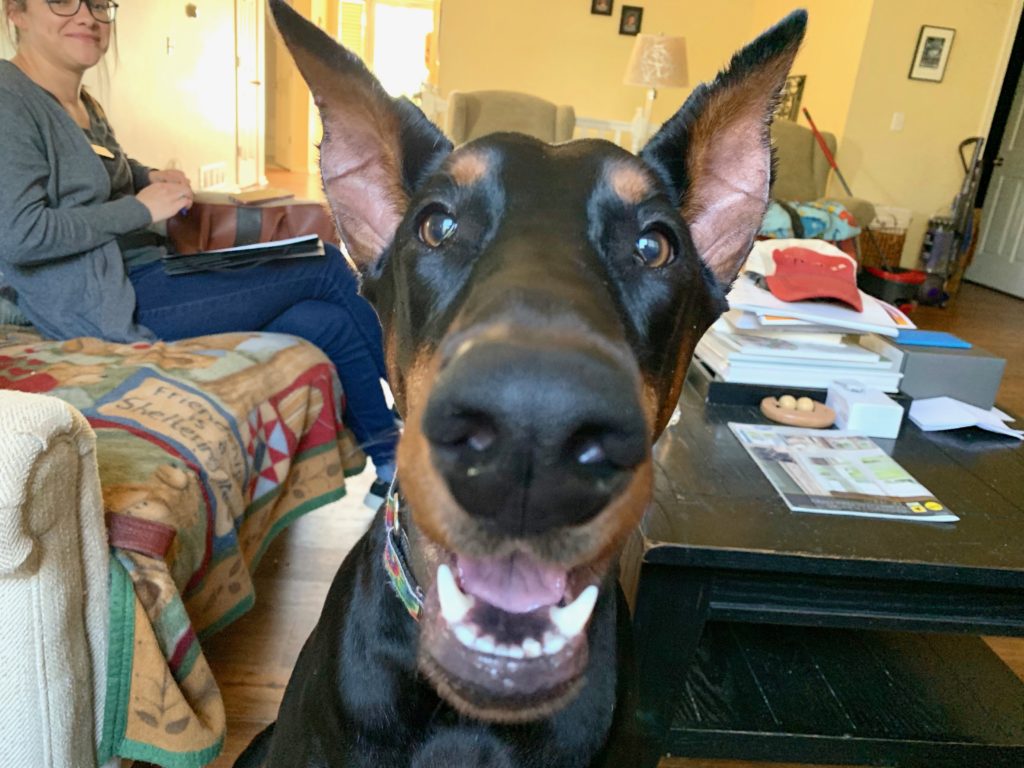Teaching a Doberman to Wait for Permission to Go Out the Door
By: David Codr
Published Date: October 30, 2019
For this Omaha dog training session we teach 2 year-old Doberman Pinscher Sophie to wait for permission to go out an open door to help her develop self control.
The reason I was called in to help is Sophie has started to go after the other dog she lives with, Eddie a 12 year-old Parson’s Terrier who thinks he runs the show.
After Sophie started going after Eddie, the guardian had started to keep them separated as he could not identify the trigger that caused the dog fight. As a result I spent most of my time working with the bigger dog who started the fights, Sophie.
It only took a few moments to realize that a lack of self control and zero respect for boundaries was a big contributing factor in this case. She excitedly wiggled around the room, was super nosy; sticking her distinguished snout into my bag, crotch, treat pouch, etc. She also literally climbed up on her guardian, almost crawling up from back and over to his front.
It wasn’t hard to see what she acted this way. Number one, she is basically still a puppy so the energy and exuberance should be expected. Her guardian did a great job of exercising her, but it was only once or twice a day and usually at the end of the day. Not often enough for a high energy dog like Sophie.
Additionally, Sophie’s guardian reached out and instinctively started to pet her each time she would invade his space or climb on him. I pointed out that anything a dog is doing when you pet it is what you are rewarding and reinforcing. The more he petted her when she climbed on him, the more likely it was for her to do it again. This is a common dog behavior problem that is caused by humans. Knowing this will go a long ways towards treating it.
When you combine a high energy dog with insufficient exercise, a lack of rules and structure and another dog who thinks he is running the show, it’s not uncommon for the dogs to have conflicts.
I suggested the guardian start petting Sophie & Eddie with a purpose, reward desired behaviors, increase Sophie’s exercise to multiple times a day, introduce rules and learn some impulse control exercises. My apprentice Taylor showed Sophie the leave it command, something all the members of the family should practice until they can give the command and have Sophie obey.
Mastering the drop command should also be on the family’s “to do” list as Sophie has shown some resource guarding behaviors in the past.
Another great way for a dog to develop self control is to delay gratification for things the dog really likes or wants. Since barreling out the door is almost the definition of lack of self control and something one of the family members wanted to stop, I decided to show them how to teach a dog to wait for permission to go out an open door.
You can watch me as I train the dog to stay and wait for permission to go out the door in the free dog training video below.
It was great seeing the dog learn to wait for permission to go out the door. All it took was a few minutes of practice, breaking the activity down into small steps and then practicing them one at a time until the dog was behaving how we wanted at each step. Each time she offered a different, unwanted behavior, we reset and started again.
After I showed the dog how to wait for permission to go out the door, I had the guardian practice the exercise too. It took him a little longer, but that’s ok as this was his first time. With some practice, anyone in the family should be able to go and open the door and have the dog wait at the door on its own.
Transitioning back to the dog fights, while separating the dogs was a wise decision to stop the fights from happening, it can actually highlight / memoriarize the last fight. Memory engrams that are freshest are what sticks in the brain most prominently. This is why you always want to end an exercise or dog training on good repetition. But if you break up a dog fight, then dont get the dogs back together when they are no longer reacting, the fight is the last thing they remember about the encounter.
Id like to see the guardian start getting the dogs back together in controlled situations where Sophie has been appropriately exercised first. Walking the dogs together a few times a day and using a tether or x pen can all help the dogs start producing fresh and positive memory engrams. They should start small, but gradually increase the number of and duration of the encounters together.
I go over a number of suggestions on how the humans can create positive interactions and associations together in the roadmap to success video below. Combined with the tips I shared to help Sophie develop respect for personal space and some self control – the dogs will be in a much better place and on the road to being able to hang out together again.
Categorized in: Dog Behavior


